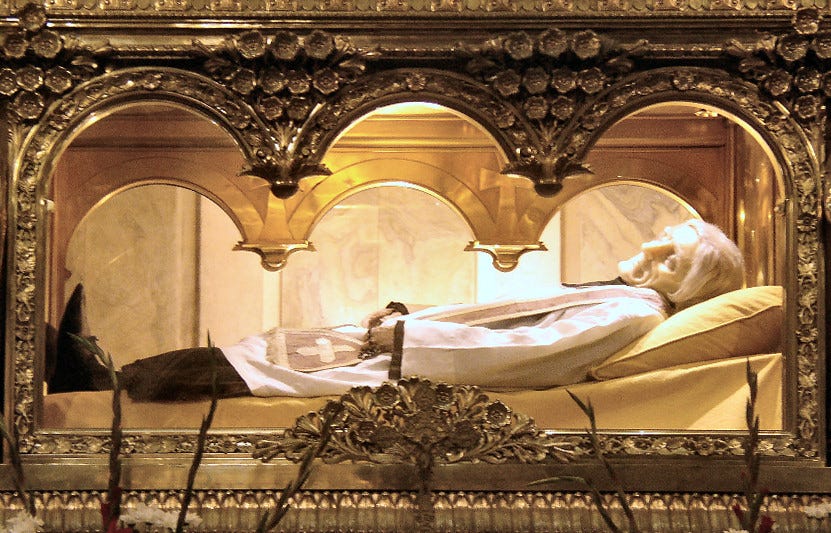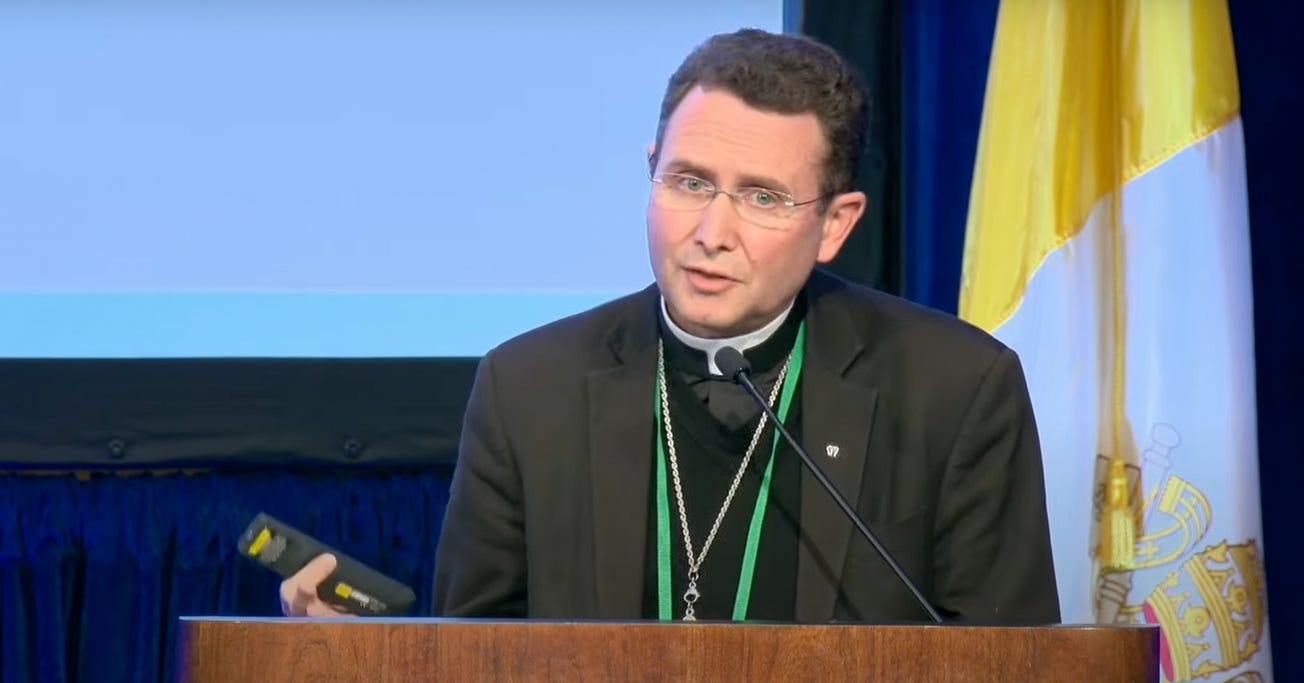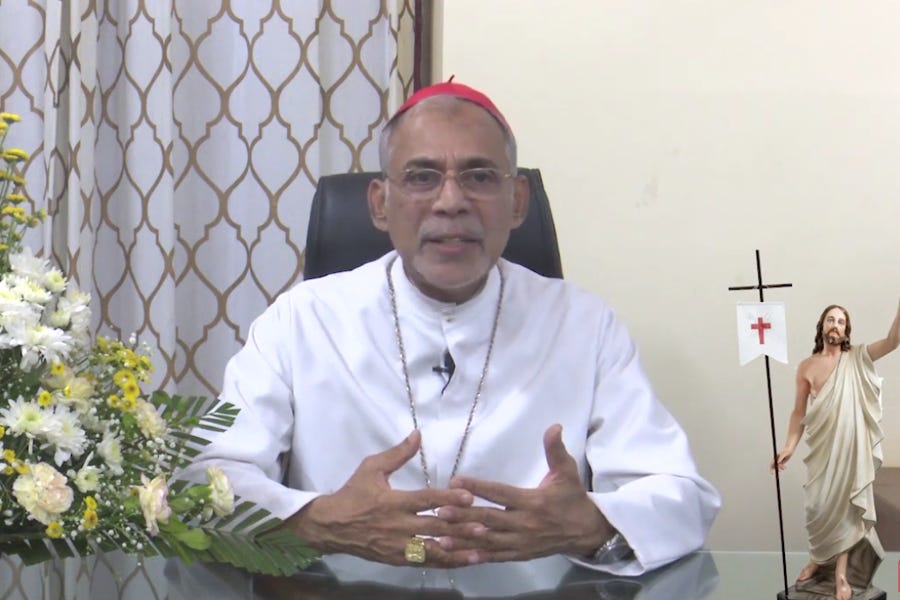Hey Everybody,
Welcome to the Tuesday Pillar Post.
You’re getting this email a bit later in the day than you usually do — not because of some late-breaking news, but for a more mundane reason — I am a little under the weather. Please accept my apologies.
Tomorrow, August 4, is the feast of the Curé d'Ars, St. Jean-Baptiste-Marie Vianney, the patron of parish priests and confessors, a witness of the fruit that is borne from a life of generous dedication to the pastoral work at the heart of priesthood.

In 2009, the Church’s Year for Priests, Pope Benedict XVI wrote compellingly on the lessons of the saint:
The Curé of Ars was very humble, yet as a priest he was conscious of being an immense gift to his people: “A good shepherd, a pastor after God’s heart, is the greatest treasure which the good Lord can grant to a parish, and one of the most precious gifts of divine mercy”. He spoke of the priesthood as if incapable of fathoming the grandeur of the gift and task entrusted to a human creature: “O, how great is the priest! … If he realized what he is, he would die… God obeys him: he utters a few words and the Lord descends from heaven at his voice, to be contained within a small host…”.
Explaining to his parishioners the importance of the sacraments, he would say: “Without the Sacrament of Holy Orders, we would not have the Lord. Who put him there in that tabernacle? The priest. Who welcomed your soul at the beginning of your life? The priest. Who feeds your soul and gives it strength for its journey? The priest. Who will prepare it to appear before God, bathing it one last time in the blood of Jesus Christ? The priest, always the priest. And if this soul should happen to die [as a result of sin], who will raise it up, who will restore its calm and peace? Again, the priest… After God, the priest is everything! … Only in heaven will he fully realize what he is”.
These words, welling up from the priestly heart of the holy pastor, might sound excessive. Yet they reveal the high esteem in which he held the sacrament of the priesthood. He seemed overwhelmed by a boundless sense of responsibility: “Were we to fully realize what a priest is on earth, we would die: not of fright, but of love… Without the priest, the passion and death of our Lord would be of no avail. It is the priest who continues the work of redemption on earth… What use would be a house filled with gold, were there no one to open its door? The priest holds the key to the treasures of heaven: it is he who opens the door: he is the steward of the good Lord; the administrator of his goods … Leave a parish for twenty years without a priest, and they will end by worshiping the beasts there … The priest is not a priest for himself, he is a priest for you”.
Tomorrow, the feast of St. John Vianney, is a great day to thank a priest for the generosity of his ministry.
St. John Vianney, pray for us!
In the news
Over the weekend, Pope Francis named the the former vice president and health minister of Taiwan as a member of the Vatican’s Pontifical Academy of Sciences.
This is the sort of appointment that might seem insignificant, but is actually laden with meaning. Why?
Because the Holy See is one of the few sovereign entities in the world to maintain diplomatic relations with Taiwan, despite pressure from Beijing to regard the island as a Chinese province instead of an independent nation. The Holy See maintains diplomatic relations with Taiwan even amid its controversial agreements with Beijing regarding the governance of the Church in China.
Appointing a high-level Taiwanese politician to a Vatican organization — even a kind of think tank like the Pontifical Academy of Sciences — will be read in Taiwan and Beijing as a discreet signal of support for the ongoing relationship between the Vatican and Taiwan.
Yesterday, Ed assessed the move in the context of the Holy See’s diplomatic balancing act with Beijing:
The Holy See is the last European government and the most prominent diplomatic power to maintain formal relations with Taiwan. But those relations have come under strain since a 2018 agreement between the Vatican and China, which grants the Communist Party certain prerogatives in the appointment of bishops for the mainland as part of the intended regularization of the status of the underground Catholic Church.
The Vatican-China deal was renewed in October last year. In the run-up to that renewal, government figures and Church leaders in Taiwan acknowledged speculation that ending formal relations with Taiwan would be a necessary condition for the Vatican to re-establish a formal diplomatic presence in Beijing — long seen as a goal of the Holy See’s Secretariat of State.
Since he became the Roman Pontiff in 2013, Pope Francis has been talking about the idea of “synodality” in the Church — the pope describes synodality as a way of discerning God’s will through a process of prayerful and reflective ecclesial conversations.
The pope now has a plan for what might be called a Mega-Synod™, a two-year process involving listening sessions and consultations in every diocese of the world, followed by meetings of bishops’ conferences, intercontinental synods, and finally a meeting of bishops in Rome set for October 2023.
The topic is synodality itself.
Phase One of the synod on synodality — the diocesan phase — starts in fewer than three months. (I realized that fact, by the way, because my youngest son told me on Saturday that Halloween is three months away, and while that seemed nearly inconceivable, I’ve learned never to doubt a four-year old about his proximity to trick-or-treating.)
Anyhow, to prepare for Phase One, U.S. bishops are expected to begin discussing details this month, and the USCCB has appointed a staff member — one with some synod experience — to serve as a liaison. Here’s an update on where things stand.
—
Saturday was the feast of St. Ignatius of Loyola, the mystic and missionary who founded the Society of Jesus — the Jesuits — and taught an approach to the spiritual life that has had serious impact on the Church for the last five centuries.
And this year, 2021, is a special year for Ignatius fans, because it was exactly 500 years ago that a cannonball ripped straight through St. Ignatius’ leg, which occasioned his conversion and set him on the path to sainthood.
(In honor of this, I’m going to ask my dad to tell his favorite joke, in which a pirate grapples with a series of cannonballs, at some point in The Pillar Podcast this week.)
To get you up to speed on Ignatius, we put together a reading and watching list for you, which includes a video of the daily statue unveiling at his tomb. (If you’ve grown up watching YouTubes, think of this daily custom is as the original unboxing video.)
‘A frank and complete acknowledgment’
In his letter on St. John Vianney, Pope Benedict acknowledged the scandals born of clerical misconduct, which the Church in the U.S. has experienced acutely in the past three years. The now-emeritus pope wrote of:
situations which can never be sufficiently deplored where the Church herself suffers as a consequence of infidelity on the part of some of her ministers. Then it is the world which finds grounds for scandal and rejection. What is most helpful to the Church in such cases is not only a frank and complete acknowledgment of the weaknesses of her ministers, but also a joyful and renewed realization of the greatness of God’s gift, embodied in the splendid example of generous pastors, religious afire with love for God and for souls, and insightful, patient spiritual guides.
It is, of course, not only the U.S. which has seen “scandal and rejection” as the “consequence of infidelity on the part of some of her ministers.”
And in India today, a case of clerical sexual misconduct — and a resulting fight between an apparent whistleblower and some ecclesial officials — has become the source of considerable scandal to non-Christians, occupying front-page real estate in several national newspapers.
But the story is complex, involves interlocking ecclesial problems, and points to a long road ahead — in India, and, most likely, in the West as well.
Bishop Franko Mulakkal of Jalandhar, in northern India, is accused of raping a religious sister 13 times between 2014 and 2016. The allegations first came to light in June 2018, when the sister filed a police report against the bishop. Other religious sisters have also made allegations of sexual misconduct against the bishop.
He was arrested in September 2018, and after a protracted ordeal about the admissibility of certain evidence, the bishop was charged in 2019 with rape, and his trial got underway.
The trial itself is not open to the media, but local reports say that several bishops, priests, and religious sisters have testified against Mulakkal.
Mulakkal remains technically the bishop of his diocese while facing trial, but the Vatican has appointed an administrator to govern the diocese, effectively placing him on a leave of absence.
The bishop’s trial is expected to conclude soon, and local media reports seem to expect he will be found guilty.
But in recent months, coverage of a related scandal has eclipsed the attention given to the actual trial. Here’s what happened:
After the allegations against Mulakkal became public, a group of religious sisters, priests, and lay Catholics have been outspoken advocates for his accuser, calling for the bishop to arrested, tried, and removed from his ecclesiastical office.
Sister Lucy Kalappura, a member of the Franciscan Clarist Congregation, was a leader in that movement. Her congregation reportedly preferred that she avoid demonstrating, giving comments to media, and otherwise engaging in the debate. She disagreed.
Eventually, she was formally prohibited from attending demonstrations, and she disobeyed. She bought a car with borrowed money, taught herself to drive, published two books, and continued protesting.
Tensions escalated, the matter was referred to the Clarists’ generalate in Rome, and Sister Lucy was dismissed from the order.
She appealed to the Apostolic Signatura — effectively the supreme canonical court of the Church — and she lost.
From there, things got even more interesting. Kalappura alleged that she was punished by the order for being a whistleblower, while the order said she’d had serious problems with disobedience for years.
But after she was dismissed from the order, Kalappura simply refused to move out of the convent. She said she’d been a religious for 39 years, and wouldn’t accept being “thrown out on the street.”
She took the congregation to court, arguing that she can’t be legally evicted from the convent under Indian law. She made an additional plea for police protection inside the convent, which she lost two weeks ago. No decision has been made on her eviction claim.
In the meantime, Kalappura continues to live in the convent, while also appearing in the media wearing her habit, calling herself Sr. Lucy, and saying that she will fight to “uphold my dignity as a nun.”
Is she being punished unjustly, or did she defy the governance of her religious institute? Some call her an opportunist, while others defend her as a prophet of justice. The Holy See seems to have made one decision, while the Indian media has made another. The debate is playing out across India’s newspapers, and is not likely to end anytime soon.
Sr. Lucy has said she demonstrated publicly because she didn’t trust that justice could be secured in any other way. The Church has said she ought to have followed ecclesiastical processes, and trusted her superiors. All of this takes place amid a global decline of trust in institutions and institutional authority — the kind of distrust her critics say Sr. Lucy exhibited for years, and the kind her supporters say is merited by her treatment.
Navigating the global erosion of institutional trust will be the preeminent challenge for the Church’s evangelical and pastoral mission in years and decades to come. It is also an opportunity to demonstrate the way an institution defined by Christ himself differentiates itself from the kingdoms and powers of the world. But whether lay and clerical Catholic leaders can meet that opportunity — and even what that should look like — remains to be seen. Stay tuned.
Final thoughts
If you listen to The Pillar Podcast or read this newsletter, you know that I’m a big fan of the Olympics. The team I’m most impressed with right now is American women’s volleyball, which bounced back this week from a stunning loss to Russia, and from injuries to two of its star players (both named either Jordan or Jordyn, coincidentally) to win a very tough game Sunday against a surging Italian team.
I’m not sure Team USA has an easy path to gold with stars on the sidelines, but the resolve of this team is impressive, and they’re worth following in the medal round.
—
Debate continues among some pundits about recent reporting from The Pillar on hookup app usage in ecclesiastical contexts. It is not our intention to continue engaging in discussion on the merits of our reporting, which we stand by. But if you want to read more, we think this piece, from the Wall Street Journal, encapsulates the situation well. And in the interest of fairness, here’s an alternative point of view.
—
Last week, Ed and I wrote that many diocesan bishops seem to have “punted” on implementation plans for Traditionis custodes, new legislation on the Extraordinary Form of the Mass. Archbishop Bernard Hebda gamely responded in his newspaper column that it’s more accurate to describe a diocesan study committee as a “time out” than as a “punt.”
The archbishop is probably correct. Our point was that most bishops will gather information, wait to see what other dioceses have done on the issue, and even wait for the possibility of clarity from Rome before introducing localized implementation plans. If that’s better described as a “time out” than a “punt,” the point is taken — blame the fact that Ed is English and I don’t watch that much football.
In the meantime, please be assured of our prayers, and please, pray for us — we need it.
And don’t forget to thank a priest on the feast of St. John Vianney.
Yours in Christ,
JD Flynn
editor-in-chief
The Pillar




